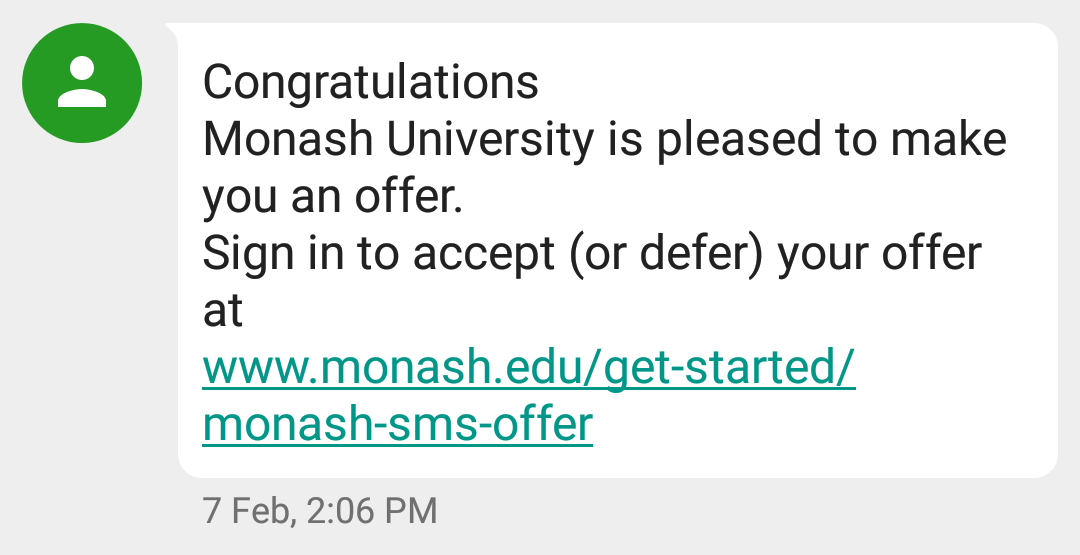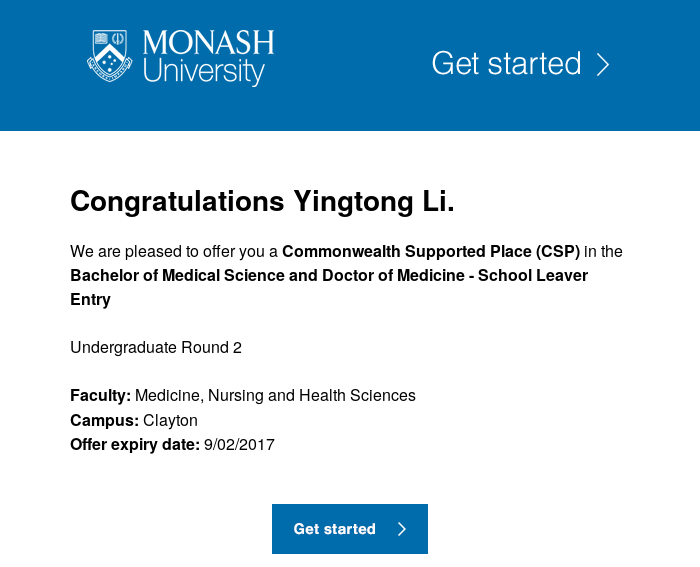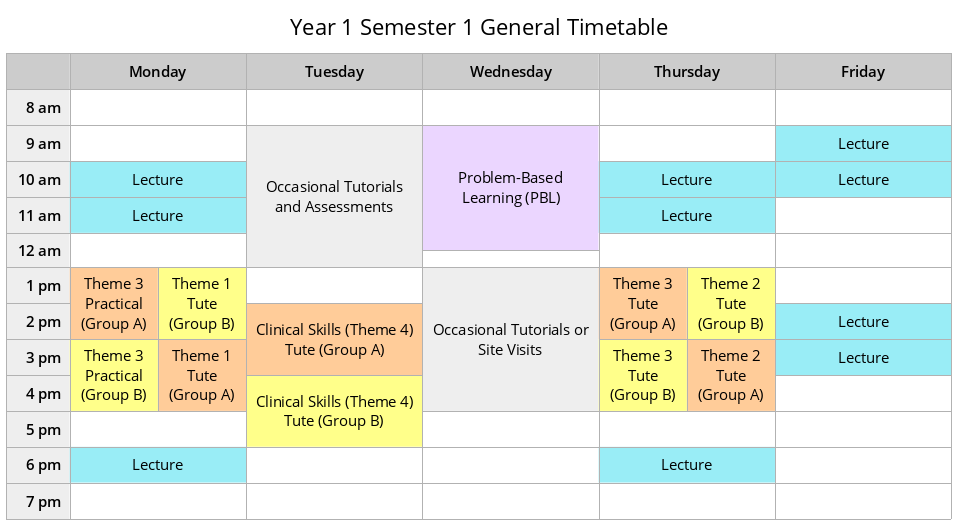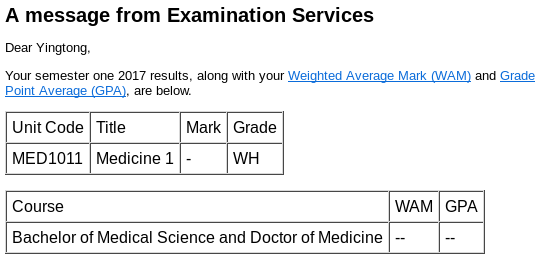Monash Medicine in review – MED1100 semester 1
New edition available
This post is quite outdated, and I've written a revised series here. For the curious, the original text of this post is below.
So let's suppose you've just graduated Year 12, got an interview offer for undergraduate medicine at Monash, and finally, it's VTAC results day.
Disclaimer: This information was correct for 2017, and has been updated where possible; however, details frequently change, and so the information in this document may be outdated, and no guarantees are made about its present accuracy. Always refer to the relevant sources for authoritative information.
Note: Prior to 2019, year 1 semester 1 was MED1011 and semester 2 MED1022. Since 2019, these have been combined into two year-long units, MED1100 and MED1200. The content is largely the same.
The verdict is in
Come results day, your interview performance is signalled with a cryptic text message from Monash.

Followed by a thankfully less-cryptic email.

After navigating through the labyrinths of the Web Enrolment System, WES, to accept the offer, you celebrate by reuniting with your old friend, Allocate+, to lodge preferences for your timetable, but it turns out that there are no preferences for medicine.

You join the ludicrous number of Monash and Monash medicine Facebook groups (Monash StalkerSpace, Monash SellYourSpace, Monash Med 20xx, MUMUS Common Room, MUMUS Marketplace, and the bewildering array of subcommittee and interest group pages), where the Preclinical Vice-President from the Monash University Medical Students' Society (MUMUS) has introduced themselves on your year-level ‘Monash Med 20xx’ page by way of a helpful indicative timetable, along with tips like ‘The slides from the enrolment information session will be uploaded online if you can't make it’ and ‘You don't need to buy textbooks just yet’.

With this in mind, you dutifully spend the rest of the month not buying textbooks and not flying to Melbourne to attend the enrolment information session. Instead, should you not have studied VCE Biology, you frantically cram the Biology Bridging Course (which turned out to be somewhat helpful but by no means necessary), before coming for O-week.
Welcome to Monash
O-week begins with the Monash University Student Theatre O-Show (this year, the Harry Potter-themed Fantastic Tips and Where to Find Them), and a ludicrous number of barbecues, tours, and free food from club stalls.
The compulsory two-day MedStart orientation programme during O-week is the first taste of the medicine programme, in the flashy new South 1 Lecture Theatre, with welcome lectures from a range of people involved with medicine at Monash, along with small-group introductions to the course (which consist mostly of making up ‘fun facts’ about onself), introductions to clinical skills (which consist mostly of trying, and not necessarily succeeding, to measure blood pressure), and introductions to ICL.
Interspersed throughout the two days are free drink bottles from faculty, merchandise and food from medical indemnity insurance companies (and free insurance, I guess), yet more barbecues, and appearances from a bewildering array of clubs, including the Monash University Medical Students' Society (MUMUS), Wildfire (rural health), Ignite (global health), the Monash Medical Orchestra, MedRevue, Operation Smile, and more.
Of particular note are the MUMUS events ‘Welcome to MUMUS’, an introduction to MUMUS and the medicine course and how to get involved, along with the MUMUS Trivia Night, and MedCruise (costumes optional).
Of course, one musn't forget the administrative miscellanea: picking up ID cards from Monash Connect, police checks, working with children checks, and immunisations.
Classes
The Monash medicine course is divided into four themes:
- Personal and Professional Development – ethics, medical law, and the self-care/lifestyle-based ‘Health Enhancement Program’ (HEP)
- Population, Society, Health and Illness – studies in public health and the social aspects of medicine known in semester 1 as ‘Health, Knowledge and Society’ (HKS)
- Foundations of Medicine: The Fabric of Life – the scientific basis of medicine
- Clinical Skills
The first day, Monday, presents a representative cross-section of these four themes, with a lecture on osmosis and body fluids, a lecture on history taking (one of the few lectures on clinical skills), a practical on histology (looking at, or at least attempting to look at, cheek cells under a microscope), and an HKS lecture. In 2018, lectures were held in the Central C1 Lecture Theatre (after the Rotunda was demolished – you'll be glad to be rid of that!).
The first week also brings a clinical skills tutorial, throwing you into the deep end with history taking – to make matters worse, it almost seems as if they start with the most awkward scenarios first. By the end of the semester, though, WWQQAA–BICE–PMHx–FHx–DRUGS–ESSENCE will roll off the tongue as easily as ‘Hi, my name's Yingtong Li; I'm a first-year medical student at Monash University. The GPs asked me to take a quick medical history today…’
The week also sees a bewildering array of PSPs (previously VESPAs; study groups for first-year students run by second-years) which, in the enthusiasm of week 1, are uncharacteristically well-attended.
Over the course of the semester, the weeks progress much the same, with weekly three-hour integrated case learning (ICL; previously PBL) sessions on topics like gastroenteritis, immunisations and HIV/AIDS. Each ICL is split between an introductory stimulus in one session in the morning to inform research for homework over the next few hours, with a conclusion to the scenario in the afternoon.
In theme 3, the main focus appears to be the biochemistry of metabolism, with contributions from basic cellular biology, embryology and gastrulation, primary tissue types, the cells of the musculoskeletal system, the principles of pharmacologic action, genetics, and ‘medicine of the mind’ (MoM).
In clinical skills, theme 4, the main focus is history taking, including responding to emotion and summarising to patients and professionals, sometimes with each other, and sometimes with simulated patients. Alongside these are a practical on hand hygiene and giving subcutaneous and intramuscular injections, which is examined in a ‘competency-based assessment’ (CBA) during the semester.
Over the course of the semester, you also take part in a site visit to a GP and a hospital, each for one morning or afternoon, to observe the workings of the practice and to interview a patient for a written ‘case commentary’ assignment. Other assignments are few in number, most notably the HKS group presentation on a contemporary Australian public health issue, and the occasional miscellaneous online activity.
The semester is punctuated by the announcement from MUMUS of the election for the first year academic and social representatives, who are to take the reins from the Preclinical Vice-President in supporting you and representing you to faculty. The weeks before the election are marked by a surge in the number of helpful posts on Facebook.
From 2018, the faculty has also introduced ‘active learning’ sessions held in the new Learning and Teaching Building opposite the bus interchange. These 90 minute sessions include consolidation sessions every few weeks on each main topic, and conclude with an online progress test to complete over the next week. The progress test is open-book, composed of multiple-choice questions (MCQs), and you have an unlimited number of attempts to complete it. The progress tests count towards a small portion of your grade, but you only need to achieve 50% on a test to receive the full grade.
In the middle of the year comes one week of mid-semester break, years 1 and 2 of the medicine programme following the standard university timetable.
After the break, content returns with a vengeance, with neuroscience, cancer, tissue injury and repair, haematology, immunology, microbiology and the pharmacology thereof being the major topics in theme 3. Meanwhile in theme 4, tutorials begin to move to a focus on giving explanations of ICL content, with a practical on measuring the four vital signs (temperature, pulse rate, respiratory rate and blood pressure), assessed in another CBA later in the semester, the week before which sees a stampede of people filling the foyer of 27 Rainforest Walk trying to borrow stethoscopes and blood pressure cuffs for practice.
Over the semester, the theme 4 skills – history taking and giving an explanation – are examined in timed 15-minute ‘clinical skills simulated encounters’ (CSSEs).
Meanwhile, swotvac arrives after week 12, wherein you frantically try to cram 7 weeks of content – helpfully assisted by the MUMUS revision lectures, run by second year students for first years – followed soon after by two written three-hour end of semester (EOS) exams, held at the Caulfield Racecourse or at Monash Sport early in the exam period, covering all content from the semester. The exam is composed of MCQs and extended matching questions (EMQs – multiple choice with an exorbitant number of choices), possibly with a small number of short-answer questions (SAQs), and includes questions from the progress tests throughout the semester.
With the written exam and CSSEs finished, you celebrate the end of the semester with your fellow students, and enjoy your nearly two months of mid-year break. And come results day, while students from other faculties are frantically refreshing their emails to see if they'll graduate on time, you needn't worry, since assessment in year 1 of medicine is combined across both semesters, and grades beyond pass/fail aren't calculated until the end of second year.

I've never tasted High Distinction – but I have a reason why!